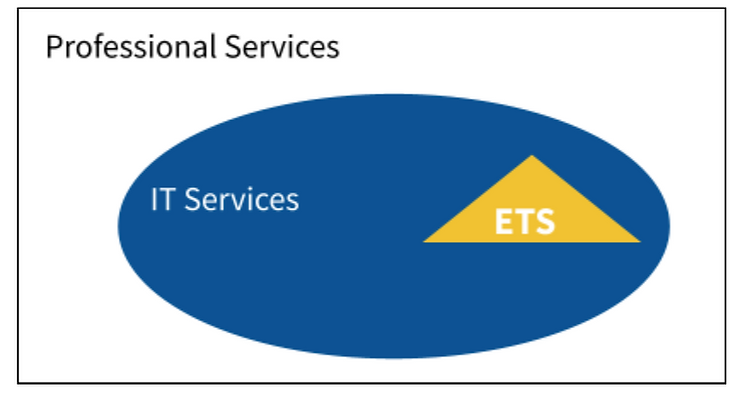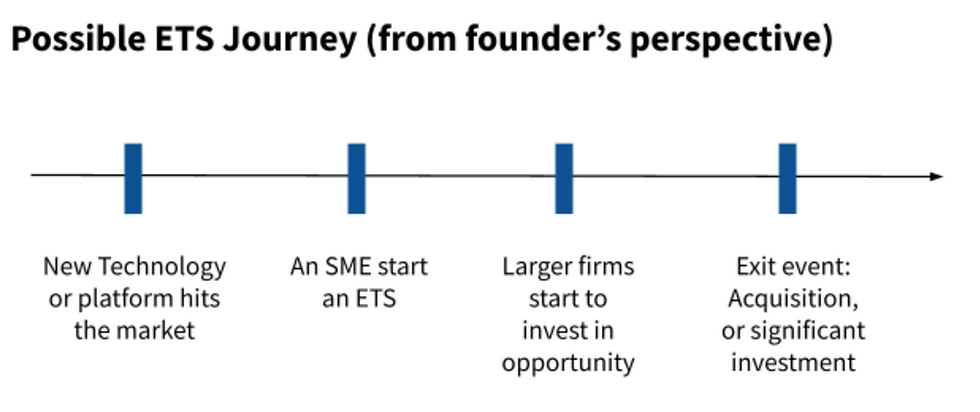In our previous post we talked about the importance of Search Engine Optimization (SEO) for...
Emerging Technology Services, a new opportunity?
Since we posted our first blog introducing Vixul , we have received several comments and questions about Vixul, about ETS, and about our goals. We will continue to publish some blogs to answer these questions. This is the first such blog. We want to explain, in more detail, Emerging Technology Services (ETS), and why we saw the need to coin the term ETS.
What is Emerging Technology Services (ETS)?
We have defined ETS as “A specialized branch of Professional Services primarily focused on adoption and management of Emerging Technologies. We define Emerging Technologies as technology platforms that are growing rapidly (at least 25% annually). ”
We will elaborate. Let us start by defining Professional services. There are many definitions on the internet but the one we find most clear is from wrike.com: “Professional services is a broad term that refers to any business or department whose core output is a service or particular expertise, rather than a manufactured product.” Common examples are accounting firms, marketing firms, and the one most relevant to us, the IT professional services firms. There are many sub-categories in IT services: consulting, managed services, development services, or IT staff augmentation – which are different in what is delivered and how. Broadly, they help clients adopt or manage technologies built by hardware or software companies. For simplicity, we will collectively refer to all as IT services. IT services are not new but we have found (through our own experience at Flux7) that building IT Services Business to help with Emerging Technologies is different, and new.

What has changed?
First, digital business has become front and center in the last decade. IT, which was a part of the back office function for decades, has now become a part of the revenue creation for many companies. Consequently, it is no longer a cost center but rather a profit center. Companies are investing in their IT proactively in order to gain competitive advantage. A lot of companies are willing to pay for IT tools and services more than ever before.
Second, with the advent of SaaS, the meaning of software/hardware companies has changed. Not just software, but even hardware, can now be consumed over the internet using an API. This has enabled some very profitable business models like SaaS and IaaS. It has also lowered the barrier to entry for customers to try new technologies and experiment with the cutting edge without making a big investment. Overall, this has catapulted the speed of adoption of new technologies, e.g, AWS, Azure, SnowFlake, etc.
Where ETS helps
The challenge, however, is the same with any new technology – shortage of talent. The major difference is that the education and training mechanisms are still catching up to the stride of the new technology and the demand is much bigger and stronger this time than before (a data point worth noting is that technology salaries have seen unprecedented increases since 2020). IT Services firms that focus specifically on these new-age, emerging technologies are now considered very valuable talent pools with good understanding of the problems and the solutions. These are what we call Emerging Technology Services or ETS.
ETS is different
Just for the ease of reference, in the rest of the blog, we will call the IT services that primarily derive income from established technologies, Traditional Technology Services or TTS.
While ETS and TTS are both a subset of IT services, and there are similarities, they are fundamentally different business models.
The financial benchmarks are fundamentally different
In a TTS, the primary health metric is profit with a focus on growth. This is because the business is operating in a stabilized market and the biggest opportunity to optimize is to minimize cost and increase profits. Cost is king and every decision is looked at through the cost lens. In traditional technologies, the services are more commoditized and customers hold the power to drive prices low. This leads to low gross margins – 30% gross margins are considered great in TTS.
In contrast, in ETS, the primary focus is growth with just marginal focus on profits. Every decision is looked at from this lens, and it is good practice to sacrifice profit to capture growth (if you have the growth mindset, more of this in the next blog). This leads to very different operating principles. For example, hiring is done ahead of the demand despite the realization that this can lead to the cost of people sitting idle on a bench (more on this below). In ETS, the services are new, and not commoditized. The providers retain power to control pricing and 60% average gross margins are common; gross margins below 45% are considered mediocre.
|
|
TTS |
ETS |
|
Gross Margin |
30% is great |
45% is typical |
|
Organic Growth Rate |
20% is great |
40% is average |
Growth mindset is a requirement
In TTS, markets are stable and efficient operations to maximize profits leads to a strong business. In ETS, growth is critical. Market is expanding if a firm is not growing at the same rate as the market, it is effectively rescinding. In a TTS, a 20% YoY growth is considered healthy. In ETS, growth below 40% is considered slow. 100% growth is not uncommon, and the super star firms grow even faster. Therefore, the primary metric of success becomes growth (at reasonable gross margins).
Resource Model is different
In TTS, services are more commoditized, and there are more talent pools out there looking to be hired. This allows them to hire on demand. In ETS, recruiting typically happens nearly out of synch with sales. Talent is short, so ETS companies either have very long hiring cycles or require a longer onboarding/training to bring a non-expert up to speed. Both mean that hiring on demand is not an option and recruiting has to be done in anticipation of demand. As it plays out in the real world, one of the two is always late – either too many people sit on the bench or some contracts have to be turned down due to shortage of resources. Matching capacity with demand is thus a major challenge. A growth-focused business thus has to bite the bullet and hire well ahead of the curve, often leading to lower net margins – despite the higher gross margins. A conservative, cost-focused, business chooses to turn down contracts. This is what differentiates the business with a growth mindset from those with a sustenance mindset. We plan to write a blog series to cover this.

Pricing is not based on cost
Due to commoditized services, a TTS business is typically focused on what they can provide, how they will be better than the next guy, and why they will come out cheaper with a higher ROI. In this case, a lot of focus goes on being cheaper and replacing competitors and existing vendors.
Due to the different resourcing model, ETS businesses actually run higher bench and recruiting/training costs. Consequently, even though gross margins are higher, the net profit is not necessarily higher. To make the business sustainable, they need to price services at a higher gross margin. This requires them to find techniques to justify the higher prices, e.g., build more IP, which further increases the costs – and costs not tied directly to delivery. Consequently, it is common for ETS services to find creative ways to price services such that they are not connected to the resources being used to deliver a service.
This has also led to new innovations in delivery practices, and use of automation to speed up delivery but charge by metrics different than just a per-hour rate. This also opens a whole new set of opportunities for ETS firms to invest in their service portfolio and IP catalog, and one of the fundamental reasons they look different than a TTS business on a P&L and Balance sheet.
|
|
TTS |
ETS |
|
Pricing strategy |
Based on costs plus gross margin |
Often orthogonal to cost to increase gross margin |
|
Pricing to customer |
Priced based on number of people being deployed |
Priced closer to the value being delivered |
Sales motions are different
TTS businesses are selling services around established technologies. Customers often understand the need for such technology or may already be using it, but are looking for a partner to either operate or upgrade what they have. The focus of the conversation is mostly on the kind of engineers the TTS firm can bring to the table and the cost of the services has to be competitive. Customers have the skills to evaluate who the best engineers are and can vet pricing by comparing to what they get from others.
ETS businesses have a very different sales motion. The first hurdle is to explain to the customer why the new technology is even useful. Thus, well-run ETS businesses for this reason spend a lot more on marketing, especially digital marketing, just to raise awareness about the technology they focus on. Next hurdle is to convince clients that the ETS business is the right partner. This requires third party validation as the clients often do not have the skills to gauge the expertise of a partner. Public case studies thus carry a lot more weight and have to become one of the biggest success metrics of a company.
Third party validators from alliances are also critical. Unlike TTS, where big analyst firms can help, ETS businesses are by definition in areas where big analyst firms have not yet published their rankings (e.g., Gartner’s Magic Quadrant) thus the platform partners’ validations and badges carry a lot of weight. Due to the pricing argument above, ETS businesses are often better off not talking in terms of people and hourly rates, rather a very consultative sales motion is focused on understanding their problem and solutions architecture has to be developed. ETS MSAs and SOWs are often non-standard due to the pricing methods discussed above, which leads to another friction point with procurement teams. Combine it all, and an ETS sales job is actually closer to a SaaS company than a TTS.
|
|
TTS |
ETS |
|
Buyer Goal |
Seeking to save money and time for solving a known problem |
Trying to solve an unknown problem and seeking expert help and guidance |
|
Marketing |
Low investment, mainly in to the brand and services |
Invested in raising market awareness, and thought leadership |
|
Lead generation |
Look for a contract expiration or a new project added to roadmap |
Use the marketing funnel to understand intent and get in to conversations with customers to educate them |
|
Sales motion |
RFPs, more focused on the engineering resources and their skill levels. Personnel resumes are shared. |
Consultative; led by solution architects to design a solution |
|
Alliances |
Mainly a resell or lead sharing mechanism |
A source of credibility and joint go to market is common |
The ETS opportunity for entrepreneurs
One interesting positive of ETS is that the playing field is a lot more leveled. Large incumbents often have a leg up in TTS, but in ETS, the smaller, more nimble firms actually have an advantage that they can learn a new technology faster and take it through the motions to launch services quickly. Large TTS firms actually are right in their accord – it is wise for them to wait until a technology has been proven before they jump in. This is actually one of the biggest opportunities for ETS founders.
An ETS company can be the spearhead in a new technology and as they mature and build a name for themselves, the underlying technology matures and gets ready for the big market. The incumbents at this time decide to jump in and fast track their journey by acquiring an ETS firm, which has established itself as an expert. And, for a well-run firm run with the growth mindset (more on this in the next blog), it can lead to a permanent life changing outcome for the founders.

To conclude, it is due to all of these fundamental differences that we decided to coin the term Emerging Technology Services (ETS). Creating this delineation is what we believe can help the entire ecosystem including ETS founders in understanding their challenges, customers understanding this perspective, and investors in evaluating this opportunity.
To connect it back, we have been on the ETS journey as founders and have lived through the lack of an ecosystem to help ETS companies. This is why we have set Vixul’s purpose “to make available to ETS founders what is commonplace today for SaaS founders,''. If you are an ETS founder, you can learn more about our first offering, the Vixul Accelerator, at http://www.vixul.com . If you are interested in ETS, you can apply to join the Vixul community here.
Our next set of blogs will discuss what we mean by the growth mindset for ETS founders, and provide actionable tips on how to grow an ETS. Please subscribe to our blog for updates.





